Development and validation of cancer-associated fibroblasts-related gene landscape in prognosis and immune microenvironment of bladder cancer
- PMID: 37397364
- PMCID: PMC10309557
- DOI: 10.3389/fonc.2023.1174252
Development and validation of cancer-associated fibroblasts-related gene landscape in prognosis and immune microenvironment of bladder cancer
Abstract
Backgrounds: Bladder cancer (BLCA) is one of the most prevalent cancers of the genitourinary system, the clinical outcomes of patients with BLCA are bad, and the morbidity rate is high. One of the key components of the tumor microenvironment (TME) is cancer-associated fibroblasts (CAFs) which are critically involved in BLCA tumorigenesis. Previous studies have shown the involvement of CAFs in tumor growth, cancer progression, immune evasion, angiogenesis, and chemoresistance in several cancers such as breast, colon, pancreatic, ovarian, and prostate cancers. However, only a few studies have shown the role of CAFs in the occurrence and development of BLCA.
Methods: We have retrieved and merged the data on RNA-sequencing of patients with BLCA from databases including "the Cancer Genome Atlas" and "Gene Expression Omnibus." Next, we compared the differences in CAFs-related genes (CRGs) expression between normal and BLCA tissues. Based on CRGs expression, we randomly divided patients into two groups. Next, we determined the correlation between CAFs subtypes and differentially expressed CRGs (DECRGs) between the two subtypes. Furthermore, the "Gene Ontology" and "Kyoto Encyclopedia of Genes and Genomes pathway" enrichment analyses were conducted to determine the functional characteristics between the DECRGs and clinicopathology.
Results: We identified five genes (POF1B, ARMCX1, ALDOC, C19orf33, and KRT13) using multivariate COX regression and "Least Absolute Shrinkage and Selection Operator (LASSO) COX regression analysis" for developing a prognostic model and calculating the CRGs-risk score. The TME, mutation, CSC index, and drug sensitivity were also analyzed.
Conclusion: We constructed a novel five- CRGs prognostic model, which sheds light on the roles of CAFs in BLCA.
Keywords: bladder cancer; cancer-associated fibroblasts (CAF); immune microenvironment; prognosis; tumor microenvironment.
Copyright © 2023 Zhang, Zhu, Zhang, Li, Min, Li and He.
Conflict of interest statement
The authors declare that the research was conducted in the absence of any commercial or financial relationships that could be construed as a potential conflict of interest.
Figures
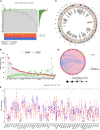
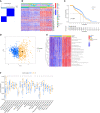


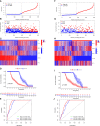
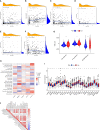
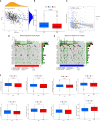
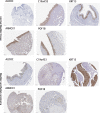
Similar articles
-
Identification of cuproptosis-related subtypes, construction of a prognosis model, and tumor microenvironment landscape in gastric cancer.Front Immunol. 2022 Nov 21;13:1056932. doi: 10.3389/fimmu.2022.1056932. eCollection 2022. Front Immunol. 2022. PMID: 36479114 Free PMC article.
-
Cuproptosis-related risk score predicts prognosis and characterizes the tumor microenvironment in colon adenocarcinoma.Front Oncol. 2023 Jun 2;13:1152681. doi: 10.3389/fonc.2023.1152681. eCollection 2023. Front Oncol. 2023. PMID: 37333810 Free PMC article.
-
Cancer-associated Fibroblasts in Bladder Cancer: Origin, Biology, and Therapeutic Opportunities.Eur Urol Oncol. 2023 Aug;6(4):366-375. doi: 10.1016/j.euo.2023.02.011. Epub 2023 Mar 6. Eur Urol Oncol. 2023. PMID: 36890105 Review.
-
Identification of a tumor microenvironment-related seven-gene signature for predicting prognosis in bladder cancer.BMC Cancer. 2021 Jun 10;21(1):692. doi: 10.1186/s12885-021-08447-7. BMC Cancer. 2021. PMID: 34112144 Free PMC article.
-
Comprehensive analysis of scRNA-Seq and bulk RNA-Seq reveals dynamic changes in the tumor immune microenvironment of bladder cancer and establishes a prognostic model.J Transl Med. 2023 Mar 27;21(1):223. doi: 10.1186/s12967-023-04056-z. J Transl Med. 2023. PMID: 36973787 Free PMC article.
Cited by
-
The prognostic significance and clinical relevance of stem cell characteristic in bladder cancer.Heliyon. 2024 Feb 1;10(3):e24858. doi: 10.1016/j.heliyon.2024.e24858. eCollection 2024 Feb 15. Heliyon. 2024. PMID: 38333832 Free PMC article.
-
Live bacteria found in gastric cancer tumor tissue.Front Microbiol. 2025 Jun 18;16:1591735. doi: 10.3389/fmicb.2025.1591735. eCollection 2025. Front Microbiol. 2025. PMID: 40606178 Free PMC article.
-
Identification of immune-related prognostic biomarkers in triple-negative breast cancer.Transl Cancer Res. 2024 Apr 30;13(4):1707-1720. doi: 10.21037/tcr-23-1554. Epub 2024 Apr 25. Transl Cancer Res. 2024. PMID: 38737702 Free PMC article.
-
An Exercise Immune Fitness Test to Unravel Disease Mechanisms-A Proof-of-Concept Heart Failure Study.J Clin Med. 2024 May 29;13(11):3200. doi: 10.3390/jcm13113200. J Clin Med. 2024. PMID: 38892912 Free PMC article.
-
Current Status of Breast Cancer Immunotherapy and Prognosis-Related Markers.Breast Cancer (Dove Med Press). 2025 Apr 15;17:339-348. doi: 10.2147/BCTT.S506949. eCollection 2025. Breast Cancer (Dove Med Press). 2025. PMID: 40256248 Free PMC article. Review.
References
LinkOut - more resources
Full Text Sources
Research Materials
Miscellaneous

